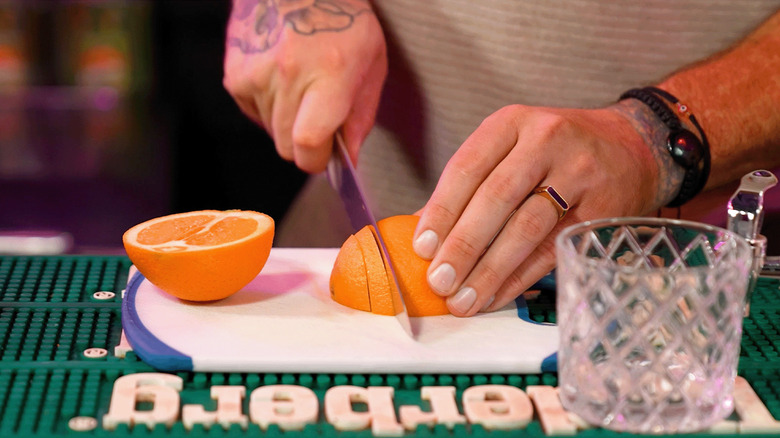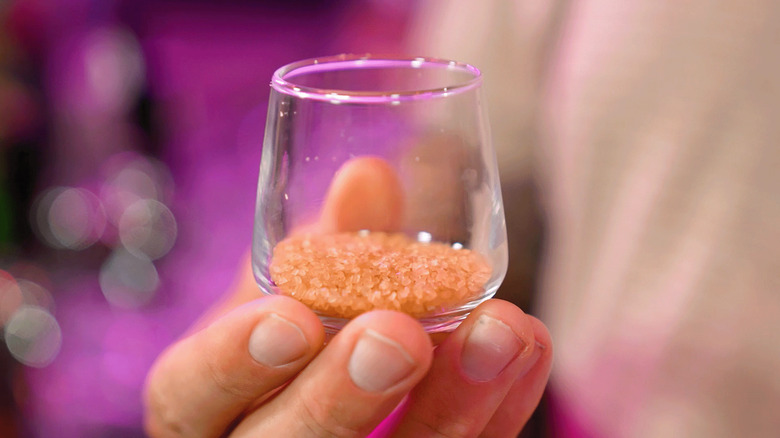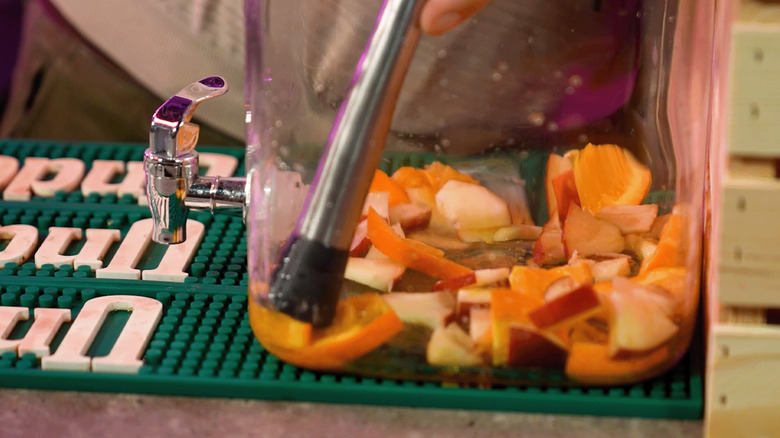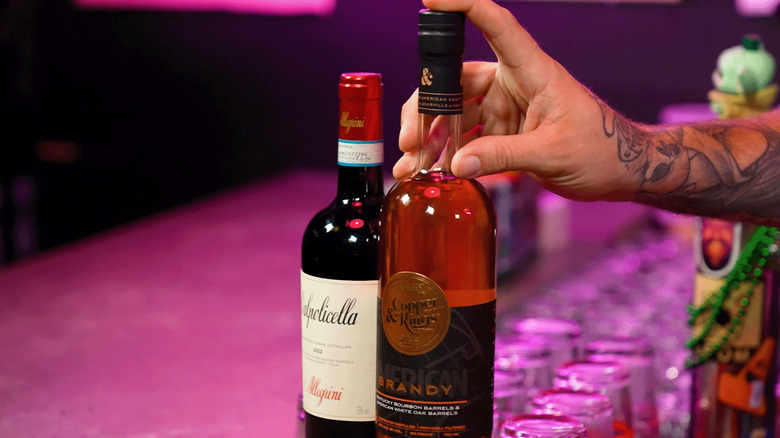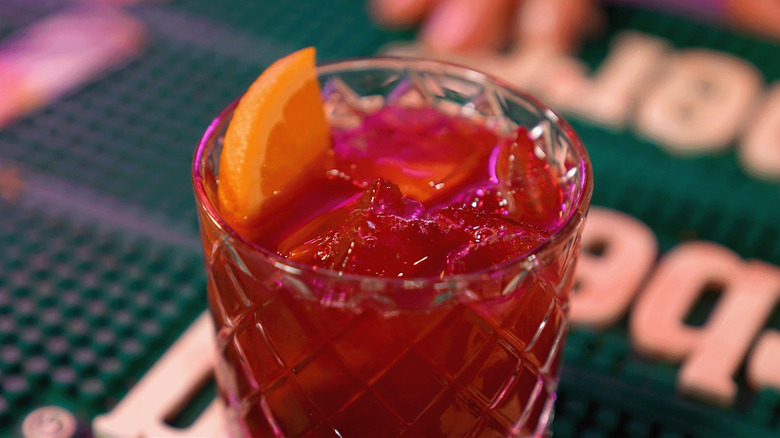How To Make Sangria - You're Doing It All Wrong
Sangria is the perfect marriage of fruit and wine. It's a great happy-medium type of drink, offering traditional wine flavors with a more refreshing, cocktail-style take. And one sip makes you feel like you're sitting under the sun in a seaside Spanish town.
This drink usually comes in two forms: red or white sangria. Though pretty self-explanatory, red sangria is made with red wine and paired with fruits that better complement those deep, rich red notes. White sangria is made with white wine, and it's often a little sweeter than its red counterpart. But as with any classic drink, the best sangria requires technique. In this "You're Doing It All Wrong" video, craft bartender Kamaron Lockwood offers his expertise on what it takes to make the best sangria. While the process is generally easy, you need to make sure you properly prepare the fruit, choose the right wine and additional spirits or juices, and give all of those flavors enough time to come together. In Lockwood's example, he opts to pair red wine with brandy, fruit juice, and plenty of fruit.
The best sangria starts with preparing the fruit
Depending on the type of sangria you're making, the fruit you choose to include will vary. Oranges add a burst of citrus to sangria, so Lockwood loves them — but he mentions that you should always include the rind. "The rind is going to have a lot of flavor; it's also going to help keep the fruit from breaking down too fast," he says, adding that it makes the overall sangria flavors more complex.
With apples, which are also commonly used in sangria, removing the seeds is imperative to improving the experience. If you have an apple corer, this is a great time to use it. Regardless of what fruit you choose to incorporate, Lockwood says that you want the slices to be uniform, which not only looks nice but also helps with the speed at which the sugars break down in the drink. When slicing, save half of each type of fruit for garnishing the finished glass later on.
Sangria needs a little added sugar
Fruit has natural sugars that add sweetness to the drink, but to help build the complexity in tandem with the acidic wine, you should plan to bring a little sugar into the mix. You can use white sugar or brown sugar, but Lockwood prefers the latter. "It's a little bit richer, and I think it goes really nicely with the brandy and wine," he says. Still, he notes that if you have cane sugar available, you can use it without issue.
Avoid turning the sugar into a syrup; instead, add raw or whole sugar right into the sangria batch. The harder sugar can be muddled, unlike the syrup — and muddling is essential for marrying the fruit and sugar together. It adds a nice texture and helps break down the sugars in the fruit, Lockwood notes. He uses about four tablespoons of sugar for every one bottle of wine in a batch.
Don't forget to muddle the fruit
If you've ever seen a bartender or mixologist take a club-like tool and press it into the ingredients in your drink glass, then you've likely witnessed muddling. In order to facilitate the process of bringing flavors into a drink, bartenders will often push them down (sort of in a mortar-and-pestle fashion), to essentially crush or bruise them and release their flavor notes. Lockwood says this is an essential step to building the most flavorful sangria.
"It's important to muddle the fruit just lightly," Lockwood says. "It starts to break down the acids in the fruit, and it turns those juices." He also notes that the muddling process helps the fruit break down "a little bit quicker and more evenly," which makes it easier to blend with whatever wine and spirits you're using. You don't need to break the fruit up entirely, and should leave it mostly whole.
Don't stick to just wine
While you might think of sangria's ingredients as being primarily fruit and wine, there are often other liquids added. This helps in two ways: more flavor, of course, but it also creates greater volume in the batch. In Lockwood's sangria, he adds orange juice with the wine and brandy and says it can be pulp or pulp-free, depending on your preferred texture. For one bottle of wine, use ¾ cup of orange juice.
For a dry red sangria, try pairing it with brandy. Lockwood says you can substitute another spirit, such as rum, but he prefers brandy's flavor in the sangria specifically because of how it's made. "It's my number one choice ... brandy is made from apples, so it blends really well with this." He suggests adding ⅓ cup of brandy to the mixture as a starting point, but also says you can adjust the brandy or sugar depending on what you prefer and shouldn't be afraid to test out the ratios.
Finally, the most the important liquid: the wine. Lockwood strongly suggests choosing a red wine for its dryness rather than focusing on which part of the world it's from. "It's really important that there's a dryness to it," he explains. "Balance is everything." A dry wine will make sure the sangria isn't too sweet. He uses an Italian Valpolicella, which is a semi-dry red, but said a pinot noir would work well, too.
Let the sangria sit for at least four hours
Just before letting the sangria marinate, Lockwood suggests completing the mixture with a cup of ice. The fruit, juice, and liquor elements all create a strong flavor, so the ice acts as a dilution. From there, it's time to let the sangria sit. "You definitely want to make sure that you have time for the sugar to dissolve and break down, and finish rounding out all of the tastes and notes," Lockwood says, adding that a four- to 12-hour window is probably your best bet.
You can certainly make the sangria ahead of time, but don't let it go untouched for too long. "I would not let this sit and drink it any more than after 48 hours," Lockwood says, "but that doesn't mean that it's going to be bad after 24." If you plan to put it in a pour spout, you should utilize those fruits you initially set aside as garnishes in each glass. You can also serve the sangria in a pitcher or bowl, and people can pour or scoop their own fruit. If desired, you can serve it over ice for further dilution. If you take the time to prep and muddle your fruit, choose the perfect mix-ins, and give your creation time to sit, you'll find yourself with some seriously sip-worthy sangria. Salud!
